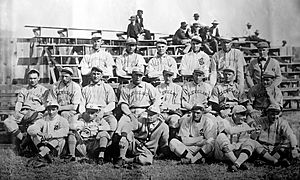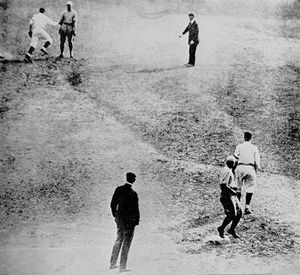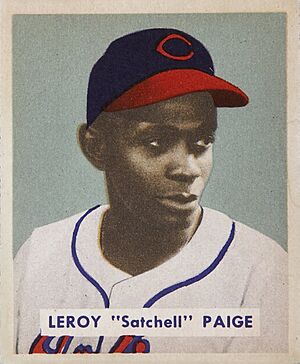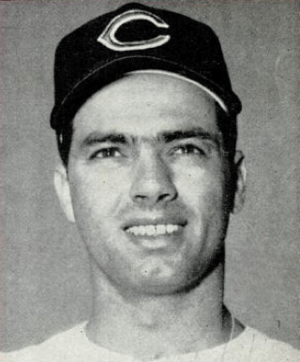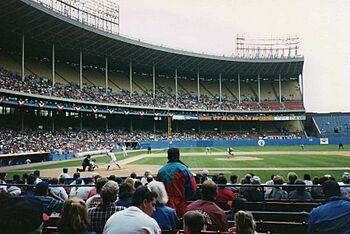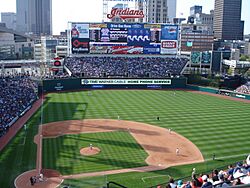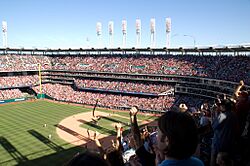History of the Cleveland Guardians facts for kids
The Cleveland Guardians are a professional baseball team from Cleveland, Ohio. They play in the Central Division of Major League Baseball's American League. Since 1994, their home field has been Progressive Field. The team started in 1900 as the Lake Shores. Back then, the American League (AL) was a minor league. In 1901, the team became one of the AL's first eight major league teams in Cleveland.
Contents
- Early Days: From Lake Shores to Naps
- Post-War Powerhouse and New Ownership
- Struggles and Changes (1960-1993)
- New Era: Central Division and World Series Runs (1994-2001)
- Shapiro Years: Rebuilding the Team (2002-2010)
- Antonetti Years: New Leadership (2011-2021)
- Cleveland Guardians Era (2022-Present)
- See also
Early Days: From Lake Shores to Naps
The team started in 1896 as the Columbus Buckeyes in Ohio. They were part of the Western League. In 1897, they changed their name to the Columbus Senators. In 1899, the team moved to Grand Rapids. Then, in 1900, the team moved to Cleveland and was called the Cleveland Lake Shores.
Around this time, Ban Johnson changed his minor league Western League to the American League. In 1901, the Cleveland team was called the "Bluebirds" or "Blues." This was when the American League became a major league. Cleveland was one of its first eight teams.
Coal owner Charles Somers and tailor Jack Kilfoyl owned the new team. Players did not like the name "Bluebirds." Writers often called them "Blues" because of their blue uniforms. In 1902, players tried to change the name to "Bronchos," but it did not stick.
The Bluebirds had money problems in their first two years. Somers thought about moving the team to Pittsburgh or Cincinnati. Help came in 1902 because of a conflict between the National and American Leagues. Napoleon "Nap" Lajoie, a star player for the Philadelphia Phillies, joined the A's in 1901. The Phillies tried to force Lajoie to return. However, a lawyer found that the order only worked in Pennsylvania.
The A's traded Lajoie to the Blues to thank Somers for his help. Lajoie arrived in Cleveland on June 4 and was an instant hit. He drew 10,000 fans to League Park. Soon after, he became team captain. The team was then called the "Naps" after a newspaper contest.
Lajoie became manager in 1905. The team improved and almost won the pennant in 1908. But success did not last. Lajoie quit as manager in 1909 but kept playing.
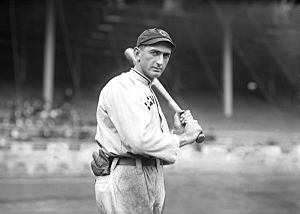
After Lajoie stepped down, the team struggled. Kilfoyl sold his share to Somers. Cy Young, who returned to Cleveland in 1909, was not effective. Addie Joss died before the 1911 season.
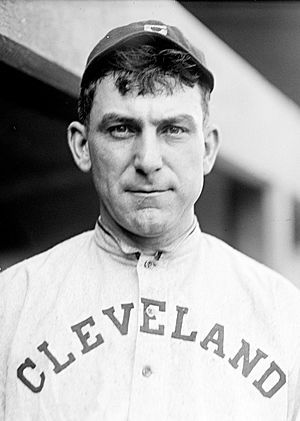
Despite strong hitters like Lajoie and Shoeless Joe Jackson, poor pitching kept the team from winning. One reporter called them the "Napkins" because they "fold up so easily." The team finished last in 1914 and 1915.
In 1915, big changes happened. Lajoie, almost 40, was no longer a top hitter. He was also fighting with manager Joe Birmingham. The team sold Lajoie back to the A's.
With Lajoie gone, the club needed a new name. Somers asked local baseball writers for ideas. Based on their suggestions, the team was renamed the Cleveland Indians. Some say the name honored Louis Sockalexis, a Native American player who played in Cleveland (1897–1899). However, this is debated by sportswriters. Sockalexis played only 96 games in three seasons.
History professor Jonathan Zimmerman says the name "Indians" was not to honor Sockalexis. Instead, it referred to the "fun" he brought to crowds. Journalists jokingly called the team the "Cleveland Indians" even when they were officially the Spiders.
Around the same time, Somers' businesses began to fail. The Indians were playing poorly, so attendance and money suffered. Somers traded Jackson in 1915 for two players and $31,500. This was a very large sum for a player back then.
First World Series Title in 1920
By 1916, Somers sold the team to a group led by Chicago railroad owner James C. "Jack" Dunn. Manager Lee Fohl, who took over in 1915, got two minor league pitchers, Stan Coveleski and Jim Bagby. He also traded for center fielder Tris Speaker, who had a salary dispute with the Red Sox. These three players helped Cleveland win a championship.
Speaker became player-manager in 1919. He led the team to a championship in 1920. On August 16, the Indians played the Yankees in New York. Shortstop Ray Chapman was batting against Carl Mays, who threw underhand. It was late afternoon, and the field was shadowy. Back then, pitchers would dirty the ball. This made it hard to see and caused it to move strangely.
Chapman did not move when Mays' pitch hit him in the head. He died the next day. He was the only player to die from a pitched ball. The Indians were in a close race for the pennant. But Chapman's death did not stop them. Rookie Joe Sewell hit .329 after replacing Chapman.
In September 1920, the Black Sox Scandal became public. Eight Chicago White Sox players were suspended. The White Sox lost games, while Cleveland won. Cleveland finished two games ahead of Chicago. They won their first pennant. Speaker hit .388, Jim Bagby won 30 games, and Coveleski played well.
Cleveland beat the Brooklyn Robins 5–2 in the World Series. They won their first title. They won four games in a row after the Robins led 2–1. Game 5 in Cleveland had three memorable "firsts." Right fielder Elmer Smith hit the first Series grand slam. Jim Bagby hit the first Series home run by a pitcher. Second baseman Bill Wambsganss made the first (and only) unassisted triple play in World Series history.
The team did not reach this level again for 28 years. Speaker and Coveleski were getting older. The Yankees were rising with Babe Ruth and the home run. Cleveland finished second twice but spent most of the decade near the bottom. In 1922, owner Jim Dunn died. His widow, Edith Dunn, took control. She was one of the first women to own a major league team. She left decisions to Ernest Barnard, the general manager.
The Bradley Years and Bob Feller
In 1927, Edith Dunn sold the team for $1 million. A group led by Alva Bradley bought it. Bradley was a well-known Cleveland businessman and a big baseball fan. This group brought stability to the team.
The Indians were an average team in the 1930s. They usually finished third or fourth. But the Great Depression caused money problems for the owners. In 1932, some owners sold their shares.
1936 brought a 17-year-old pitcher named Bob Feller to Cleveland. He came from Van Meter, Iowa, with a powerful fastball. That season, Feller set a record with 17 strikeouts in one game. He led the league in strikeouts from 1938 to 1941. In 1938, Indians catchers Hank Helf and Frank Pytlak caught baseballs dropped from the 708-foot (216 m) Terminal Tower.
By 1940, Feller, along with Ken Keltner, Mel Harder, and Lou Boudreau, led the Indians close to the pennant. But the team had disagreements. Some players even asked to fire manager Ossie Vitt. Reporters called them the "Cleveland Crybabies." Feller, who had pitched a no-hitter and won 27 games, lost the final game. The Detroit Tigers won the pennant.
Cleveland started 1941 with a young team and a new manager, Roger Peckinpaugh. But the team finished fourth. Cleveland soon lost two stars. Hal Trosky retired in 1941 due to headaches. Bob Feller joined the U.S. Navy after the attack on Pearl Harbor. Third baseman Ken Keltner and outfielder Ray Mack were drafted in 1945.
Post-War Powerhouse and New Ownership
In 1946, Bill Veeck and an investment group bought the Cleveland Indians. They paid $1.6 million. Famous comedian Bob Hope, who grew up in Cleveland, was one of the investors. Veeck was known for his creative promotions. He once hired Max Patkin, the "Clown Prince of Baseball," as a coach.
One of Veeck's biggest achievements was breaking the color barrier in the American League. He signed Larry Doby, a player from the Negro league's Newark Eagles, in 1947. This was eleven weeks after Jackie Robinson joined the Dodgers. Doby faced racism but hit .301 in 1948. He led the American League in home runs twice and is now in the Hall of Fame.
Veeck moved the team to the large Cleveland Municipal Stadium. Before 1947, the Indians played most games at League Park. League Park was torn down in 1951.
Veeck used a movable center field fence in the stadium. He could move it to help the Indians against their opponents. The fence could move up to 15 feet (5 m). After 1947, the American League changed the rule. Outfield walls had to stay in place for a whole season. The stadium allowed the Indians to set a record for the largest crowd at a Major League baseball game. On October 10, 1948, over 84,000 fans watched Game 5 of the World Series against the Boston Braves.
In 1948, Veeck signed pitching great Satchel Paige from the Negro leagues. Paige was barred from Major League Baseball during his best years. Many saw Veeck's signing of the aging star as a publicity stunt. At 42, Paige became the oldest rookie in Major League history. He was also the first black pitcher. Paige finished the year with a 6–1 record and a 2.48 ERA.
Veterans Boudreau, Keltner, and Joe Gordon had great offensive seasons. Newcomers Larry Doby and Gene Bearden also played well. The team won a one-game playoff against the Boston Red Sox. This was the first in American League history. They went to the World Series. The Indians beat the Boston Braves four games to two. They won their first championship in 28 years. Boudreau won the American League MVP Award.
In 1949, Veeck's first wife divorced him. She was entitled to half of his share of the team. Veeck had to sell the team to a group led by Ellis Ryan for $2.5 million. In 1950, Hank Greenberg became general manager.
A strong team with Feller, Doby, Minnie Miñoso, Luke Easter, Bobby Ávila, Al Rosen, Early Wynn, Bob Lemon, and Mike Garcia continued to compete. But Cleveland only won one pennant in the 1950s. They finished second to the New York Yankees five times.
The team's winningest season was in 1954. The Indians finished with a record of 111–43 (.721). This set an American League record for wins. It stood for 44 years. The Indians returned to the World Series to play the New York Giants. But they lost in a sweep. The series is famous for Willie Mays' over-the-shoulder catch in Game 1.
In 1956, Mike Wilson sold the team for $3.96 million. A group led by William Daley bought it. Hank Greenberg was fired in 1957. It was found he planned to move the club to Minneapolis.
Frank Lane: "Trader" Lane
The Indians hired Frank Lane as general manager in 1957. Lane was known as "Trader" Lane because he loved to make deals. He once said the only deals he regretted were the ones he did not make.
One of Lane's early trades sent Roger Maris to the Kansas City Athletics in 1958. Indians executive Hank Greenberg and Maris were not happy. After Maris broke Babe Ruth's home run record, Lane defended himself. He said Maris was unknown then, and he got good players in return.
In 1959, Lane got Norm Cash from the White Sox. He traded Cash to Detroit before Cash played a game for the Indians. Cash went on to hit nearly 375 home runs for the Tigers. The Indians got Steve Demeter, who had only five at-bats for Cleveland.
Struggles and Changes (1960-1993)
From 1960 to 1993, the Indians struggled. They finished third once (1968) and fourth six times. Most of the time, they were at or near the bottom.
The Rocky Colavito Trade
In 1960, Lane made a trade that defined his time in Cleveland. He traded popular slugger Rocky Colavito to the Detroit Tigers for Harvey Kuenn. Colavito was the 1959 AL home run co-champion. Kuenn was the AL batting champion. After the trade, Colavito hit over 30 home runs four times. He made three All-Star teams before returning to Cleveland in 1965. Kuenn played only one season for the Indians.
Akron Beacon Journal writer Terry Pluto wrote a book called The Curse of Rocky Colavito. It described the team's long struggles after the trade. Colavito said he never cursed the Indians. He said the trade happened because of a salary dispute with Lane.
Lane also traded managers in 1960. He sent Joe Gordon to the Tigers for Jimmy Dykes. Lane left in 1961. But bad trades continued under new GM Gabe Paul. In 1965, Paul traded pitcher Tommy John, who won 288 games, and 1966 Rookie of the Year Tommy Agee to get Colavito back.
Ownership Changes and Financial Issues
Constant changes in ownership and management hurt the Indians. Team President Mike Wilson died in 1962. Daley took over. Two months later, general manager Gabe Paul bought enough stock to be the largest shareholder. In 1966, Daley and Paul sold control to Vernon Stouffer, who owned the Stouffer's food company. Paul stayed as general manager.
Before Stouffer bought the team, low attendance led to talk of moving. A wealthy owner from Cleveland seemed like what the team needed. But Stouffer's money problems started when the stock of Litton Industries, which bought Stouffer's, dropped. The team had little money. Stouffer cut the player development budget. This hurt the Indians for years.
Stouffer agreed to play at least 30 home games in New Orleans. He thought about moving the team there. He sold the team in 1972 to a group led by Nick Mileti. Mileti founded the Cleveland Cavaliers. Stouffer said his time as owner was the longest five years of his life.
Struggles Continue in the 1970s
Lou Piniella, the 1969 Rookie of the Year, and Luis Tiant both left. The 1970s were not much better. The Indians traded away future stars like Graig Nettles, Dennis Eckersley, Buddy Bell, and 1971 Rookie of the Year Chris Chambliss. They got players who did not make an impact.
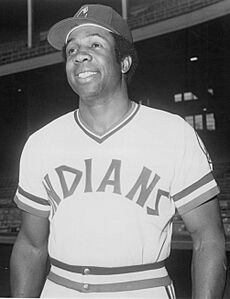
In 1973, Paul sold his share of the Indians. He joined George Steinbrenner's group that bought the Yankees. Phil Seghi became general manager. Mileti stepped aside as chief operating officer. Alva T. "Ted" Bonda took control of daily operations.
The team kept losing seasons from 1969 to 1975. One bright spot was getting Gaylord Perry in 1972. The Indians traded "Sudden Sam" McDowell for Perry. Perry became the first Indian pitcher to win the Cy Young Award.
In 1975, Cleveland broke another color barrier. They hired Frank Robinson as Major League Baseball's first African American manager. Robinson was a player-manager. He hit a pinch hit home run on Opening Day. But the team did not improve with Robinson as manager.
The 1970s also had the famous Ten Cent Beer Night at Cleveland Municipal Stadium. This event in a 1974 game against the Texas Rangers ended in a riot. The Indians had to forfeit the game.
In 1977, 22-year-old pitcher Dennis Eckersley threw a no-hitter. Robinson was fired and replaced by Jeff Torborg. Mileti's group sold the team for $11 million. A group led by Francis J. "Steve" O'Neill bought it. Former GM Gabe Paul was part of this group.
The next season, Eckersley was traded to the Boston Red Sox. He won 20 games in 1978. The Tribe lost 90 games in 1978. Torborg's 1979 team struggled. Dave Garcia became manager in July.
Bright Spots in the 1980s
The 1980s brought some good moments. In May 1981, Len Barker threw a perfect game. He joined Addie Joss as the only Indians pitchers to do so. "Super Joe" Charbonneau won the American League Rookie of the Year. But Charboneau left baseball by 1983 due to back injuries. Barker also struggled with injuries.
The Indians traded Barker to the Atlanta Braves for Brett Butler and Brook Jacoby. They became key players for the team. Butler and Jacoby joined Joe Carter, Mel Hall, Julio Franco, and Cory Snyder. This brought new hope to fans in the late 1980s.
Cleveland hosted the 1981 All-Star Game. It was scheduled for July 14 but was delayed by a players' strike. The game was held on August 9. The National League beat the American League 5–4. Over 72,000 people attended, setting an All-Star Game attendance record.
O'Neill's death in 1983 meant the team was for sale again. Richard and David Jacobs bought the team in 1986. After a rare winning season in 1986, Sports Illustrated predicted the Indians would win in 1987. Instead, the team lost 101 games. This was the worst record in baseball.
The film Major League (1989) showed Cleveland's struggles. It comically showed a bad Cleveland team going from last to first.
Turning the Team Around
Throughout the 1980s, Indians owners wanted a new stadium. Cleveland Stadium was old and falling apart. In 1984, a plan for a new stadium was voted down.
In May 1990, voters passed a tax on alcohol and cigarettes. The money would build the Gateway Sports and Entertainment Complex. This included Jacobs Field for the Indians and Gund Arena for the Cleveland Cavaliers basketball team. The team had new owners and a new stadium coming. Now they needed a winning team.
The team's luck began to change in 1989. They made an unpopular trade. They sent power-hitting outfielder Joe Carter to the San Diego Padres. They got two unproven players, Sandy Alomar Jr. and Carlos Baerga. Alomar made an immediate impact. He was an All-Star and won Cleveland's fourth Rookie of the Year award and a Gold Glove. Baerga became a three-time All-Star.
Indians general manager John Hart made many good moves. In 1991, he hired former Indian Mike Hargrove to manage. He traded catcher Eddie Taubensee to the Houston Astros for Kenny Lofton. Lofton finished second in AL Rookie of the Year voting.
Baseball America named the Indians "Organization of the Year" in 1992. This was because of new hitting stars and an improving farm system.
The team faced a tragedy in spring training of 1993. A boat carrying pitchers Steve Olin, Tim Crews, and Bob Ojeda crashed. Olin and Crews died. Ojeda was seriously hurt.
By the end of the 1993 season, the team was changing. They were leaving Cleveland Stadium. They had many talented young players. Many came from the Indians' new AAA farm team, the Charlotte Knights.
New Era: Central Division and World Series Runs (1994-2001)
A Fresh Start at Jacobs Field
Indians General Manager John Hart and owner Richard Jacobs helped turn the team around. The Indians opened Jacobs Field in 1994. They hoped to improve on their sixth-place finish from the year before. The Indians were only one game behind the Chicago White Sox on August 12. Then, a players strike ended the rest of the season.
The strike also led to a strange trade. The Minnesota Twins traded Dave Winfield to the Cleveland Indians on August 31. The season had already stopped. So Winfield did not play for the Indians that year. No player was ever named in exchange. To settle the trade, Cleveland and Minnesota executives went to dinner. The Indians paid the bill. This makes Winfield the only player traded for a dinner.
1995 Season: Back to the World Series
Cleveland had a great season in 1995. They went 100–44. They won their first ever division title. Veterans Dennis Martínez, Orel Hershiser, and Eddie Murray joined young stars. These included Albert Belle, Jim Thome, Manny Ramírez, and Charles Nagy. The team led the league in batting average and ERA.
After beating the Boston Red Sox and the Seattle Mariners, Cleveland reached the World Series. This was their first time since 1954. But the World Series ended in disappointment. The Indians lost in six games to the Atlanta Braves. The Indians won the AL Central again in 1996. But they lost to the Baltimore Orioles in the playoffs. In 1996, all home game tickets for the Indians sold out before opening day.
1997 Season: Close Call in the World Series
In 1997, Cleveland started slowly. But they finished with an 86–75 record. They won their third straight AL Central title. The Indians beat the New York Yankees in the playoffs. After beating the Baltimore Orioles, Cleveland faced the Florida Marlins in the World Series. This series had the coldest game in World Series history.
The series was tied after Game 6. The Indians led 2–1 in the ninth inning of Game 7. But closer José Mesa allowed the Marlins to tie the game. In the eleventh inning, Édgar Rentería hit the winning run. The Marlins won their first championship.
Cleveland was the first team to lose the World Series after leading in the bottom of the ninth inning of Game 7.
1998-2001: More Playoff Appearances
In 1998, the Indians made the playoffs for the fourth year in a row. They beat the Boston Red Sox. But Cleveland lost to the New York Yankees in the ALCS. The Yankees had won 114 games that season.
For the 1999 season, Cleveland added Ricardo Rincón and Roberto Alomar. They won the Central Division title. This was their fifth straight playoff appearance. The team scored 1,009 runs. They were the first team since 1950 to score over 1,000 runs in a season. But Cleveland lost in the first round to the Red Sox. They had led the series two games to none.
In 2000, the Indians started 44–42. But they played well after the All-Star break. They finished 90–72. The team had one of the best offenses. But they finished five games behind the Chicago White Sox. They missed the wild card by one game. Mid-season trades brought Bob Wickman and Jake Westbrook to Cleveland. Manny Ramírez left for Boston after the season.
The Indians set a Major League record for most pitchers used in one season. Bartolo Colón, Dave Burba, and Chuck Finley had strong seasons. But other starting pitchers struggled.
In 2000, Larry Dolan bought the Indians for $320 million from Richard Jacobs. This was a record for a baseball team sale at the time.
2001 saw a return to the playoffs. After Manny Ramírez and Sandy Alomar Jr. left, the Indians signed Ellis Burks and former MVP Juan González. They helped the Indians win the Central division with a 91–71 record.
One highlight was on August 5, 2001. The Indians made the biggest comeback in MLB History. Cleveland came back from a 14–2 deficit to beat the Seattle Mariners 15–14 in 11 innings. The Mariners had won a record 116 games that season.
Seattle and Cleveland met in the first round of the playoffs. The Indians led two games to one. But the Mariners won Games 4 and 5. In the 2001 offseason, GM John Hart resigned. His assistant Mark Shapiro took over.
Shapiro Years: Rebuilding the Team (2002-2010)
First Rebuilding Phase
Shapiro decided to rebuild the team. He traded older players for younger talent. He traded Roberto Alomar to the New York Mets. He got outfielder Matt Lawton and prospects Alex Escobar and Billy Traber. When the team started losing in 2002, Shapiro fired manager Charlie Manuel. He traded pitching ace Bartolo Colón for prospects Brandon Phillips, Cliff Lee, and Grady Sizemore. He got Travis Hafner from the Rangers. He also got Coco Crisp from the St. Louis Cardinals. Jim Thome left after the season for a bigger contract with the Phillies.
Young Indians teams finished far out of contention in 2002 and 2003. Eric Wedge was the new manager. They had good hitting in 2004. But the bullpen struggled, blowing over 20 saves. A highlight was a 22–0 win over the New York Yankees on August 31. This was one of the Yankees' worst losses ever.
In early 2005, the offense started poorly. But the Indians played very well in August. They cut a 15.5 game deficit to 1.5 games. However, they lost six of their last seven games. They missed the playoffs by only two games. Shapiro was named Executive of the Year in 2005.
Template:2006 in baseball, the team made some changes. They kept their young players. They got top prospect Andy Marte. The Indians had a good offensive season. Travis Hafner and Grady Sizemore had career years. Hafner tied the single season grand slam record of six. But the bullpen struggled. The Indians finished fourth.
In 2007, Shapiro signed veteran help for the bullpen and outfield. Aaron Fultz and Joe Borowski joined Rafael Betancourt in the bullpen. Shapiro also signed Trot Nixon and David Dellucci for leadership. The Indians improved a lot. They were in second place at the All-Star break. They brought back Kenny Lofton in July. The Indians finished with a 96–66 record. This was their seventh Central Division title in 13 years. It was their first playoff trip since 2001.
The Indians beat the New York Yankees in the American League Division Series. This series is remembered for the swarm of bugs in Game 2. They also led the Red Sox three games to one in the American League Championship Series. But the season ended in disappointment. Boston won the last three games to reach the 2007 World Series.
Cleveland players won many awards. Grady Sizemore won the Gold Glove award. This was Cleveland's first since 2001. Indians Pitcher CC Sabathia won the second Cy Young Award in team history. Eric Wedge won the first Manager of the Year Award for the team. Shapiro was named Executive of the Year again in 2007.
Second Rebuilding Phase
The Indians struggled in 2008. Injuries to sluggers Travis Hafner and Victor Martinez hurt the team. Starting pitchers Jake Westbrook and Fausto Carmona also had injuries. The Indians traded CC Sabathia to the Milwaukee Brewers. They got prospects Matt LaPorta, Rob Bryson, and Michael Brantley. They also traded Casey Blake for Carlos Santana.
Some players like Jhonny Peralta and Kelly Shoppach started to play well. Pitcher Cliff Lee went 22–3 and won the AL Cy Young Award. Grady Sizemore had a great year. He won a Gold Glove and Silver Slugger. The Indians finished 81–81.
Hopes for 2009 were low. The Indians were 22–30 by the end of May. Shapiro made many trades. He traded Cliff Lee and Ben Francisco to the Philadelphia Phillies. He traded Victor Martinez to the Boston Red Sox. The Indians finished last in their division. They had a record of 65–97. The team announced that Eric Wedge and his coaching staff would be released. Manny Acta was hired as the team's 40th manager.
On February 18, 2010, it was announced that Shapiro would become team President. Paul Dolan became the new Chairman/CEO. Chris Antonetti became the new GM.
Antonetti Years: New Leadership (2011-2021)
On January 18, 2011, former first baseman and manager Mike Hargrove returned as a special adviser. The Indians started 2011 very well. They were 30–15 in their first 45 games. They stayed close to the Detroit Tigers through August. But then the team struggled. They finished 80–82. This was their best record since 2008.
The Tribe thought they could compete in 2012. They started well, leading the Central for most of April and May. They were 44–41 at the All-Star Break. But the team collapsed after the All-Star Game. They finished 68–94.
Terry Francona Era Begins
The Indians fired their manager. They hired Terry Francona. He had led the Boston Red Sox to two World Series titles. They also cut several players, including Grady Sizemore, who had many injuries. These changes brought hope for 2013. The team played well in June. They earned a wild card spot. But they lost the Wild Card Game to the Tampa Bay Rays.
In 2016, the Indians won their first AL Central title since 2007. They won their first AL pennant since 1997. They played the Chicago Cubs in the World Series. They won three of the first four games. But the Cubs came back and won their first World Series since 1908.
The Indians kept winning in 2017. They won the second-most games in team history. They set an American League record by winning 22 games in a row. They lost the ALDS to the New York Yankees. The Indians won the AL Central again in 2018. But they were swept in the ALDS by the Houston Astros. In 2019, the Indians won 93 games. But they missed the playoffs.
In the 2020 season, shortened by the pandemic, the Indians finished third. They were the number four seed in the expanded playoffs. They lost the first round of the playoffs to the New York Yankees. In 2021, the team's last season as the Indians, they finished second.
Cleveland Guardians Era (2022-Present)
On July 23, 2021, it was announced that the Indians would change their name to the Guardians. This change happened at the start of the 2022 season.
The Guardians won the AL Central in 2022. But they lost the ALDS again to the Yankees.
See also


